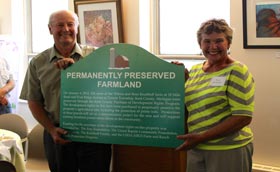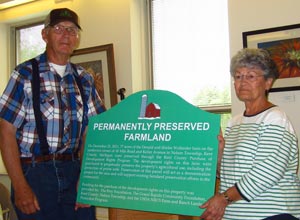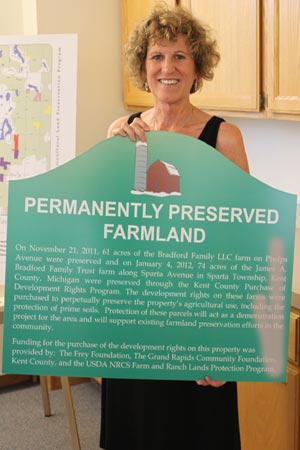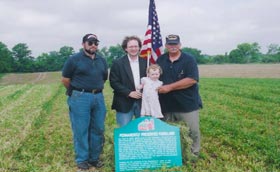On a chilly May day in 2006, Peter Wege dedicated Lloyd and Kathleen Flanagan’s 145-acre farm as Kent County’s second permanently preserved farm. Tom Howard’s 106 acre farm (pictured above), preserved the year before, was the county’s first. Since that day, 15 more working farms – a total of 1,987 acres – have been saved from creeping urban sprawl.
The Howards, the Flanagans, and the other 15 farm owners can now pass their land on to their children to farm, lease to a farmer, or sell. But their land can never be used for anything but a farm or open space. Because of Peter Wege’s belief in economicology, early on he saw the ecological and economic win-wins for preserving farmland. Kent’s almost 2,000 acres now preserved as farms might otherwise have been sold for development – one lone house on a huge parcel of land.
But don’t these big rural homes provide new tax revenue for local governments, as developers say? Quite the opposite. The sprawler’s dream of “living in the country” forces taxpayers to pay for new infrastructure. For every dollar of property tax paid by a home owner “in the country,” the local government must spend $1.15 to provide roads, water, sewer, schools, and public safety.
Compare that to the same property-tax dollar coming from farm property: local government spends only 35 cents in farmland services, a gain of 65 cents. So why do homes “in the country” cost tax dollars while farms save them? Simple. Chickens don’t go to school and cows don’t call 911.
The truth is, however, that the farmers who go through the long process of preserving their farms think beyond their finances. In 2006, Lloyd Flanagan told Peter Wege, “This farm—well, it’s life for me. My eyesight’s not good enough to drive, but I can still walk out in my fields.”
In July, 2012, Tim Howard told a busload of people learning about farmland preservation: “All the new houses going up around me just didn’t sit right.” Wilson Kruithoff told the group why he and his wife Rose made the decision to preserve. They’d bought their farm from the Clark family, the original homesteaders of the land. “I wanted to preserve the Clark family’s heritage. We didn’t do it for profit. We did it because it was the best thing for the community.”
Shirley and Don Wollander raise corn, hay, and soybeans on their 77 newly preserved acres of farmland. “Don wanted this so badly,” Shirley told the bus visitors. “It took us ten years, but thank God it’s happened.”
At $91.4 billion last year, the farming economy is Michigan’s second biggest industry and closing in on cars. Twenty-two percent of all jobs in the state are in the farm industry. Preserving farmland now is vital to Michigan’s future.




